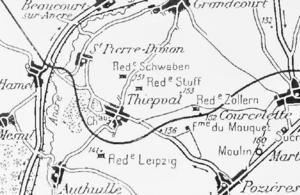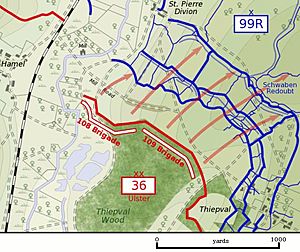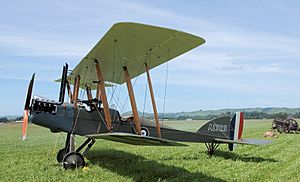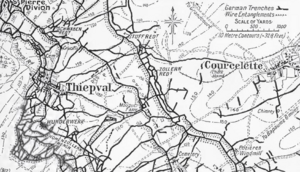Capture of Stuff Redoubt facts for kids
Quick facts for kids Capture of Stuff Redoubt |
|||||||
|---|---|---|---|---|---|---|---|
| Part of The Battle of the Somme, First World War | |||||||
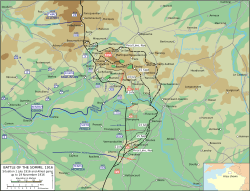 Battle of the Somme 1 July – 18 November 1916 |
|||||||
|
|||||||
| Belligerents | |||||||
| Commanders and leaders | |||||||
| Douglas Haig | General Erich von Falkenhayn | ||||||
The Capture of Stuff Redoubt was an important event during the Battle of the Somme in 1916. A "redoubt" was a strong, enclosed fort built to defend a position. The German army had built Stuff Redoubt as part of their strong defenses along the Somme front.
On the first day of the Somme battle, July 1, 1916, British troops from the 36th (Ulster) Division managed to get into part of the redoubt. However, German counter-attacks forced them to leave. The British could not reach the redoubt again until the Battle of Thiepval Ridge in late September. During this battle, soldiers from the 11th (Northern) Division captured another part of theunt. The remaining parts of the redoubt were finally taken by the 25th Division in early October, during the Battle of the Ancre Heights.
German officers felt that losing Stuff Redoubt was a big blow to their army's spirit. After the redoubt was captured, the British could see the Ancre valley and Grandcourt area from above. This made it harder for the Germans to hide their movements.
Building the Defenses
Early Days on the Somme (1914–1915)
When the First World War began, fighting on the Somme front quickly settled into trench warfare. Both sides built strong defenses. The German army's 26th Reserve Division arrived in late 1914. They tried to advance but soon had to dig in.
Artillery, which are large guns, became very important in this type of fighting. It was crucial for soldiers in the front lines to communicate with the artillery behind them. This way, the big guns could fire at the right targets. German officers worked to improve how their artillery was organized. They wanted all their guns to work together and fire effectively.
One officer, Major Bornemann, wrote a report in 1915. He pointed out problems with communication. For example, artillery observers sometimes left their posts. This meant they missed chances to help the soldiers fighting. He suggested that artillery should fire more often and in different areas. This would keep the British guessing and protect German infantry. He also said that artillery officers should be able to order fire quickly when they saw targets.
German Fortifications (1915)
In January 1915, the German army began building strong defenses across the Western Front. This was to save soldiers while they fought on the Eastern Front. They built huge barbed-wire fences, sometimes two belts wide.
The front line was made of three trenches, each about 150–200 yards apart.
- The first trench (Kampfgraben) was for small groups of guards.
- The second (Wohngraben) held the main group of soldiers.
- The third trench was for local reserves.
These trenches had zig-zag paths and concrete posts for sentries. Deep underground shelters, called dugouts, were built every 50 yards. They were deep enough to protect 25 men from shells.
Behind the front line, another strong defense line was built. This was called the Stützpunktlinie. Even further back, a second main defense line was created. This second line was built far enough away that enemy field artillery could not reach it. This forced attackers to move their guns forward, which took time.
The German artillery was set up to create "barrage sectors." This meant each infantry officer knew which artillery batteries covered their part of the front. A telephone system was also built. Lines were buried 6 feet deep to connect the front line to the artillery.
However, the Somme defenses had some weaknesses. The front trenches were on a forward slope, which meant they could be easily seen by British observers. Also, too many German soldiers were crowded near the front.
New Defenses in 1916
After battles in late 1915, the Germans started building a third defense line in February 1916. This line was almost finished when the Battle of the Somme began. More forts were built, especially in the middle and back lines.
Stuff Redoubt (Staufen-Feste) was part of this second defense line. It was located north-west of another fort called Zollern Redoubt. Beyond Stuff Redoubt was Stuff Trench, which led towards Courcelette. The redoubt was about halfway between the towns of Pozières and Grandcourt.
New artillery positions were built, and dugouts were made even deeper. Engineers carefully planned and checked all the building work. By July 1916, the German front line near Thiepval had 16 rows of barbed wire. The dugouts were 30 feet deep and could hold all the soldiers in the trenches.
The Battle for Stuff Redoubt
First Attack: July 1, 1916
Morning Attack
| Date | Rain mm |
Temp ( °F) |
|
|---|---|---|---|
| 23 | 2.0 | 79–55 | wind |
| 24 | 1.0 | 72–52 | dull |
| 25 | 1.0 | 71–54 | wind |
| 26 | 6.0 | 72–52 | cloud |
| 27 | 8.0 | 68–54 | cloud |
| 28 | 2.0 | 68–50 | dull |
| 29 | 0.1 | 66–52 | cloud wind |
| 30 | 0.0 | 72–48 | dull wind |
| 1 | 0.0 | 79–52 | fine |
On July 1, 1916, at 7:15 a.m., soldiers of the 36th (Ulster) Division moved close to the German front trench. At 7:30 a.m., the British artillery stopped firing on the front trench. The Irish soldiers advanced steadily. They crossed the first German trench with few losses. However, German machine-gun fire hit their support companies.
The leading British soldiers pushed on. They reached the second German trench line by 7:48 a.m. and captured many prisoners. But German soldiers came out of their dugouts behind them. The British continued to advance, reaching the third trench line and part of Schwaben Redoubt by 8:48 a.m. However, German machine-guns then fired from all directions, stopping their movement.
The German Reserve Infantry Regiment 99 (RIR 99) was broken through. The British attackers rushed Schwaben Redoubt. The German soldiers defending it were surprised and surrendered quickly. About 500 German soldiers were taken prisoner.
By 10:00 a.m., reports said that the third German trench line had fallen. Some British soldiers even reached a trench near Stuff Redoubt, finding it empty. About 200 men reached an artillery position in a dip called Boom Ravine.
The German commander, Soden, ordered a counter-attack to recapture Schwaben Redoubt. He sent more soldiers to help.
Afternoon Counter-Attack
British planes from 4 Squadron, Royal Flying Corps (RFC), watched the attack. They reported that German artillery was moving back. They also saw no signs of German troops gathering for a counter-attack.
However, the Germans did counter-attack. Oberstleutnant Bram reached Stuff Redoubt to lead the attack. Moving around the redoubt was very hard because of all the shell holes and constant British shelling. Bram found an observation post and saw British troops close to the German second line.
The German counter-attack began in the afternoon. It was met by heavy machine-gun fire and got stuck. More German orders came to attack immediately, but movement was very difficult for both sides.
German recruit companies advanced from Grandcourt. They attacked the British in Boom Ravine, capturing or killing them. In the center, the counter-attack from Stuff Redoubt began with three German companies. But British artillery quickly forced them to take cover.
By 6:00 p.m., German troops had fought their way back into some of the captured front line. By 7:00 p.m., more German attacks on the redoubt failed, with many casualties. At 9:00 p.m., German artillery began shelling the redoubt for an hour.
The German infantry attacked again, supported by fresh soldiers. In fierce hand-to-hand fighting, the Germans recaptured the redoubt in about 30 minutes. They found about 700 dead Irish soldiers inside. By midnight, the Germans had taken back the ridge.
British Preparations (September–October)
September Plans
The British II Corps planned to capture Hessian Trench and Stuff Redoubt. The 11th (Northern) Division was given this task. They also hoped to send patrols to Stuff Trench beyond the redoubt. Two tanks were supposed to help by driving towards Mouquet Farm.
October Preparations
By October 1, the 25th Division took over from the 11th (Northern) Division. The British now held the southern part of Stuff Redoubt, while the Germans held the northern part. Preparations began to capture the rest of the redoubt and the higher ground beyond it. This would give the British a better view of the Grandcourt valley.
Communication trenches were dug, and deep dugouts were made for the attacking soldiers. Bad weather caused delays, but the attack was set for October 9.
Key Attacks on Stuff Redoubt
September 26: Battle of Thiepval Ridge
The 11th (Northern) Division attacked with two battalions. They reached their first goal, a line near Zollern Redoubt, with few losses. However, German machine-gun fire from Zollern and Stuff redoubts stopped them. One battalion got stuck fighting in Zollern Redoubt.
The other battalion was hit by machine-gun fire. Some soldiers pushed on to Zollern Trench and gained a foothold. The Germans in Zollern Redoubt held on until Canadian soldiers on their left flank moved around them. Then, the remaining German defenders fell back to Stuff Trench, which became their new main defense line.
Fighting at Mouquet Farm
| Date | Rain mm |
Temp ( °F) |
|
|---|---|---|---|
| 23 | 0 | 66–43 | fine |
| 24 | 0 | 72–45 | mist sun |
| 25 | 0 | 73–50 | fine |
| 26 | 0.1 | 75–54 | fine |
| 27 | 0.1 | 72–52 | dull wet |
| 28 | 1 | 73–54 | fine rain |
| 29 | 17 | 61–54 | wet wind |
| 30 | 0 | 63–41 | fine dull |
Fighting continued at Mouquet Farm. The two tanks that were supposed to help got stuck. But their crews took off their machine-guns and joined the attack on foot. At 5:30 p.m., the last 56 German soldiers at the farm surrendered after being attacked with smoke bombs.
September 27: Renewed Attacks
The 11th (Northern) Division ordered another attack for 10:00 a.m. However, it took until dawn to understand the situation. At 6:30 a.m., it was found that Zollern Redoubt was empty.
The 11th Manchester battalion was supposed to advance and occupy Stuff Redoubt, which seemed to be abandoned. But as soon as it was daylight, a heavy German bombardment began. Machine-gun fire from Stuff Redoubt and Hessian Trench stopped the British advance. These positions were still held by German soldiers.
After a meeting, the British ordered another attack for 3:00 p.m. But the soldiers were very tired. New battalions were sent forward to continue the attack. The 9th West Yorkshire battalion attacked just after 3:00 p.m. They reached the south side of Stuff Redoubt and gained a foothold.
The Green Howards attacked an hour later. The Germans in Hessian Trench were surprised and captured. The Green Howards took 80 prisoners and two machine-guns. They linked up with other British units in the redoubt.
September 28–30: Holding On
The 32nd Brigade took over to capture the rest of Stuff Redoubt. They planned to link up with Canadian soldiers. However, German artillery and crowded trenches caused delays. A group of British soldiers in Stuff Redoubt attacked the north side again. They almost pushed out the last German defenders but ran out of ammunition. They had to retreat to the south side.
On September 29, Canadian soldiers attacked with the 32nd Brigade. They used Stokes mortars and a creeping barrage. They captured most of Hessian Trench and linked up with the Canadians. But a 200-yard part of the trench next to Stuff Redoubt was not captured. The British in the redoubt attacked the north side again but ran out of grenades. They had to go back to the south face.
On September 30, the British II Corps continued its attacks. They wanted to push the Germans out of Hessian Trench. British bombers attacked, and the 6th York and Lancaster advanced. The 7th South Staffordshire attacked up Zollern Trench. The troops in the south face of Stuff Redoubt attacked again. These attacks gained ground against strong German resistance. By nightfall, the British had taken their goals, except for the north side of the redoubt.
October 9–13: Final Capture
Stuff Redoubt Falls
| Date | Rain (mm) |
Temp (°F) |
|
|---|---|---|---|
| 8 | 0.1 | 64–54 | rain |
| 9 | 0 | 64–50 | fine |
| 10 | 0 | 68–46 | fine sun |
| 11 | 0.1 | 66–50 | dull |
| 12 | 0 | 61–55 | dull |
| 13 | 0 | 61–50 | dull |
| 14 | 0 | 61–50 | dull |
At 12:35 p.m. on October 9, the 10th Battalion Cheshire Regiment attacked Stuff Redoubt. They advanced behind a very strong artillery barrage. By 12:42 p.m., they had captured the north side of the redoubt. They pushed forward but did not reach the Mounds, which was their final goal on the high ground to the north.
The battalion captured 127 German prisoners and counted 50–60 German dead. Two German counter-attacks in the evening were stopped by British artillery and machine-gun fire.
On October 11, the Germans counter-attacked again. On the evening of October 12, a German storm troop, supported by a flame-thrower, managed to recapture the north-west corner of Stuff Redoubt. But they were soon forced out with many losses. October 13 was quiet.
Taking The Mounds
On October 14, the 25th Division attacked the Mounds, which were north-west of Stuff Redoubt. At 2:40 p.m., a German artillery barrage ended. The British attacked at 2:46 p.m., advancing close behind a heavy creeping barrage. They reached the Mounds with few losses. German prisoners later said they had seen the preparations but their commander did not believe an attack was coming.
The British battalion took 101 prisoners and several machine-guns. Now, the British had a clear view over the Grandcourt valley from all along the ridge. They built observation posts down the slope.
Air Operations
British balloon observers helped a lot by spotting German artillery positions. They reported 64 German batteries firing before the September 26 attack and found 103 more. British planes also directed artillery fire. For example, a group of about 1,000 German soldiers near Miraumont was scattered by artillery fire directed by a British plane.
British planes from 4 Squadron and 7 Squadron RFC watched the attack. They reported that the infantry stayed close to the creeping barrage and captured Mouquet Farm and Zollern Redoubt. Observation planes took photos of the area. British planes also dropped 135 bombs on German trenches and artillery.
60 Squadron attacked German observation balloons with rockets, shooting down two in flames. They also attacked other balloons on the ground. Two German planes were shot down, and four more were damaged by British patrols.
On September 27, many German planes were in the air until it started raining. Six British planes from 27 Squadron were attacked by five German planes, which shot down three British planes. Another British plane was lost to a German fighter.
On September 30, British planes took 500 photos. Pilots flying low over the battlefield studied the German wire and trenches. The British advance made it harder for Germans to observe from the ground. So, it became even more important to stop German air observation. British Nieuport 16 fighters were good against the faster German planes and began to escort bombers.
During another attack on a German airfield, German pilots took off and attacked the bombers. This led to a dogfight with the British escort planes. Three German fighters were shot down. The growing threat of new German fighters led to plans to increase the number of British fighter squadrons.
On October 21, a German counter-attack at Schwaben Redoubt was stopped. A British attack that had been planned for the afternoon caught the Germans off guard. The British captured their goals, helped by observation from 4 and 7 squadrons. Visibility was so good that ten German artillery positions were destroyed, 14 were damaged, and seven ammunition pits exploded. Many German artillery batteries were forced to stop firing because British planes quickly spotted them.
Aftermath
Casualties
On July 1, the 36th (Ulster) Division suffered 5,104 casualties. From September 10 to 30, the 11th (Northern) Division had 5,236 casualties. From September 26 to 30, 3,615 men were lost, with 70 percent of them wounded.
Later Operations
From November 13 to 18, the British Reserve Army finished the Battle of the Ancre Heights. They then fought the Battle of the Ancre. The Reserve Army was renamed the Fifth Army on October 30. The German defenses that General Below tried to hold were overrun. During the Battle of the Ancre, the German 1st Army suffered 45,000 casualties, including 7,183 prisoners.
|



